语言学知识
- 格式:doc
- 大小:86.00 KB
- 文档页数:15
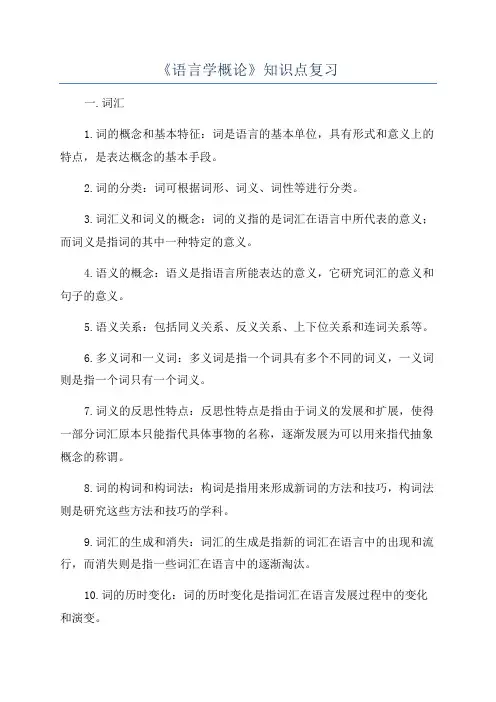
《语言学概论》知识点复习一.词汇1.词的概念和基本特征:词是语言的基本单位,具有形式和意义上的特点,是表达概念的基本手段。
2.词的分类:词可根据词形、词义、词性等进行分类。
3.词汇义和词义的概念:词的义指的是词汇在语言中所代表的意义;而词义是指词的其中一种特定的意义。
4.语义的概念:语义是指语言所能表达的意义,它研究词汇的意义和句子的意义。
5.语义关系:包括同义关系、反义关系、上下位关系和连词关系等。
6.多义词和一义词:多义词是指一个词具有多个不同的词义,一义词则是指一个词只有一个词义。
7.词义的反思性特点:反思性特点是指由于词义的发展和扩展,使得一部分词汇原本只能指代具体事物的名称,逐渐发展为可以用来指代抽象概念的称谓。
8.词的构词和构词法:构词是指用来形成新词的方法和技巧,构词法则是研究这些方法和技巧的学科。
9.词汇的生成和消失:词汇的生成是指新的词汇在语言中的出现和流行,而消失则是指一些词汇在语言中的逐渐淘汰。
10.词的历时变化:词的历时变化是指词汇在语言发展过程中的变化和演变。
二.语音1.语音的概念:语音是语言的基本要素之一,研究语言音素、音节和音系等内容。
2.音位和音素:音位指的是语音系统中不同的基本音单元,而音素则是指在一种具体语音系统中有决定意义的语音单位。
3.国际音标:国际音标是一种国际通用的音标符号,用于表示各种语言的语音。
4.声调:声调是指语音中声音的高低和音调变化。
5.语调:语调是指在一句话中语音音调的变化。
6.连读和重音:连读是指在语音流通的过程中,语音之间的相互作用和连接;重音是指在词语和句子中,一些音节能够产生的较大音量、较长时间和较高音调。
7.训练和修正:语音训练是指通过学习和练习,使得个体能够正确地使用语音来表达意义;语音修正是指对发音错误进行纠正和改正。
三.语法1.语法的概念:语法是语言结构和组织的规律和原则。
2.句子的基本概念:句子是表达完整意义的语言单位,由主语、谓语和宾语等成分组成。
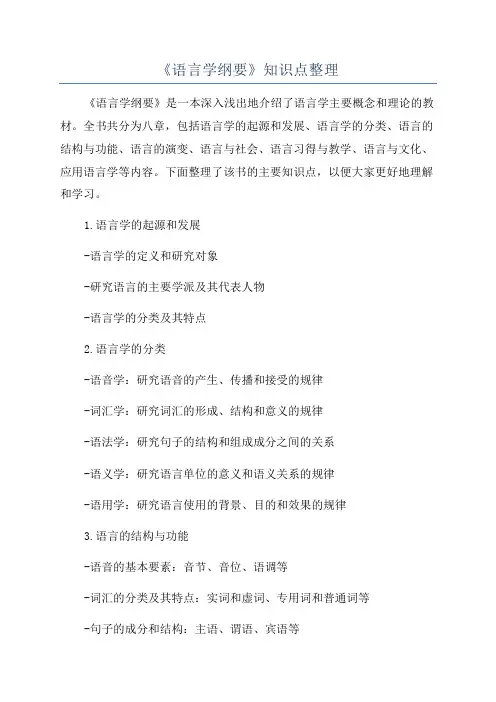
《语言学纲要》知识点整理《语言学纲要》是一本深入浅出地介绍了语言学主要概念和理论的教材。
全书共分为八章,包括语言学的起源和发展、语言学的分类、语言的结构与功能、语言的演变、语言与社会、语言习得与教学、语言与文化、应用语言学等内容。
下面整理了该书的主要知识点,以便大家更好地理解和学习。
1.语言学的起源和发展-语言学的定义和研究对象-研究语言的主要学派及其代表人物-语言学的分类及其特点2.语言学的分类-语音学:研究语音的产生、传播和接受的规律-词汇学:研究词汇的形成、结构和意义的规律-语法学:研究句子的结构和组成成分之间的关系-语义学:研究语言单位的意义和语义关系的规律-语用学:研究语言使用的背景、目的和效果的规律3.语言的结构与功能-语音的基本要素:音节、音位、语调等-词汇的分类及其特点:实词和虚词、专用词和普通词等-句子的成分和结构:主语、谓语、宾语等-语言的功能:交际功能、表达功能和认知功能等4.语言的演变-语言变异和语言变种:方言、口音等-语言变迁和语言变异的原因:历史、地理、社会等-语言接触和语言借用:外来语的影响和借词现象-语言变化的规律和趋势:语音演变、词汇演变等5.语言与社会-社会语言学的基本理论和方法-语言社会化和语言规范化:语言的习得、使用和变异的规律-语言地位和语言权力:标准语和方言的关系-语言与身份认同:地域、阶级、性别等对语言的影响6.语言习得与教学-语言习得的理论和过程:母语习得和第二语言习得-语言教学的理论和方法:教学目标和任务、教学材料和教学法-第二语言习得的问题和难点:语音、词汇、语法等方面-语言评价和测试:能力级别、智力水平等7.语言与文化-语言与文化的关系:语言是文化的载体和反映-语言与文化的差异:语义、词汇、语法等方面-语言的文化功能:人际交往、思维方式、文化传承等-语言的跨文化交际能力:语言障碍与跨文化交流8.应用语言学-应用语言学的定义和发展:语言学在实际问题中的应用-语言规范和语言政策:标准化、推广普通话等-语言工具和技术:翻译、口译、计算机语言处理等-语言研究的前沿和发展趋势:多语种研究、语料库语言学等。
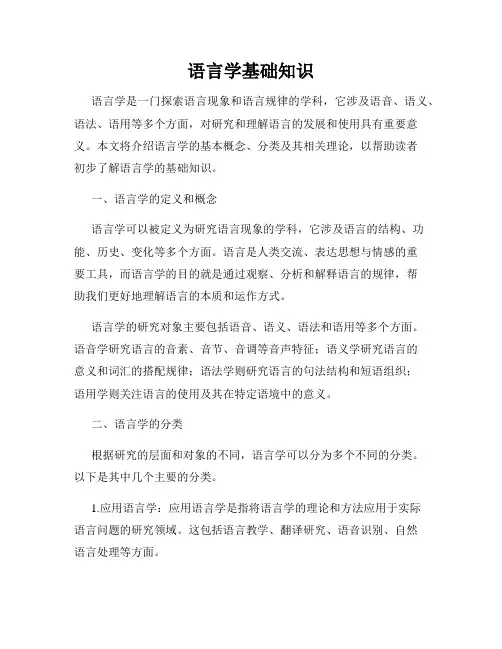
语言学基础知识语言学是一门探索语言现象和语言规律的学科,它涉及语音、语义、语法、语用等多个方面,对研究和理解语言的发展和使用具有重要意义。
本文将介绍语言学的基本概念、分类及其相关理论,以帮助读者初步了解语言学的基础知识。
一、语言学的定义和概念语言学可以被定义为研究语言现象的学科,它涉及语言的结构、功能、历史、变化等多个方面。
语言是人类交流、表达思想与情感的重要工具,而语言学的目的就是通过观察、分析和解释语言的规律,帮助我们更好地理解语言的本质和运作方式。
语言学的研究对象主要包括语音、语义、语法和语用等多个方面。
语音学研究语言的音素、音节、音调等音声特征;语义学研究语言的意义和词汇的搭配规律;语法学则研究语言的句法结构和短语组织;语用学则关注语言的使用及其在特定语境中的意义。
二、语言学的分类根据研究的层面和对象的不同,语言学可以分为多个不同的分类。
以下是其中几个主要的分类。
1.应用语言学:应用语言学是指将语言学的理论和方法应用于实际语言问题的研究领域。
这包括语言教学、翻译研究、语音识别、自然语言处理等方面。
2.历史语言学:历史语言学研究语言的发展和演变。
它通过比较不同时期和地区的语言形态、语法、词汇等,揭示语言的历史变化规律。
3.形态学:形态学研究词汇的内部结构和构词规律。
它关注词的形态形式、词根、词缀等,以及它们在句中的使用方式和句法功能。
4.句法学:句法学研究句子的结构和组成。
它关注词与词之间的关系以及它们按照一定规律组合而成的短语、从句和主句等句法单位。
5.语音学:语音学研究语言的音素、音节和音调等音声特征。
它通过观察和描述语言的发音规律,揭示不同语言之间的音位差异和音变规律。
6.语义学:语义学研究语言的意义和词汇的表义关系。
它关注词语之间的意义关联和句子的语义结构,帮助我们理解语言中的暗示、隐喻和逻辑关系。
三、语言学的相关理论1. 结构主义:结构主义是20世纪初发展起来的一种语言学理论,强调语言的内在结构和规律。
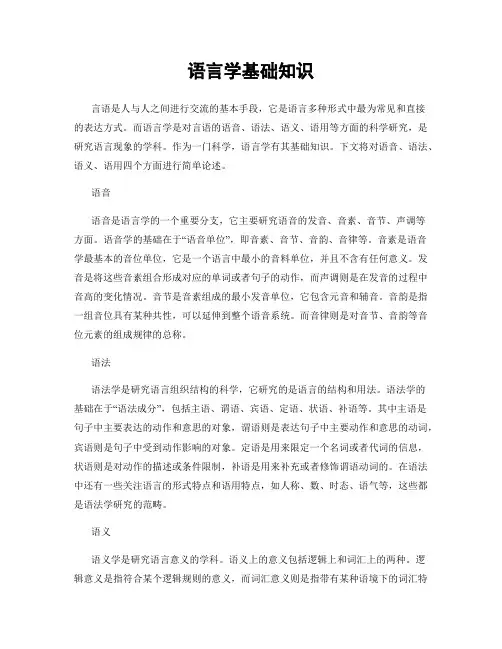
语言学基础知识言语是人与人之间进行交流的基本手段,它是语言多种形式中最为常见和直接的表达方式。
而语言学是对言语的语音、语法、语义、语用等方面的科学研究,是研究语言现象的学科。
作为一门科学,语言学有其基础知识。
下文将对语音、语法、语义、语用四个方面进行简单论述。
语音语音是语言学的一个重要分支,它主要研究语音的发音、音素、音节、声调等方面。
语音学的基础在于“语音单位”,即音素、音节、音韵、音律等。
音素是语音学最基本的音位单位,它是一个语言中最小的音料单位,并且不含有任何意义。
发音是将这些音素组合形成对应的单词或者句子的动作,而声调则是在发音的过程中音高的变化情况。
音节是音素组成的最小发音单位,它包含元音和辅音。
音韵是指一组音位具有某种共性,可以延伸到整个语音系统。
而音律则是对音节、音韵等音位元素的组成规律的总称。
语法语法学是研究语言组织结构的科学,它研究的是语言的结构和用法。
语法学的基础在于“语法成分”,包括主语、谓语、宾语、定语、状语、补语等。
其中主语是句子中主要表达的动作和意思的对象,谓语则是表达句子中主要动作和意思的动词,宾语则是句子中受到动作影响的对象。
定语是用来限定一个名词或者代词的信息,状语则是对动作的描述或条件限制,补语是用来补充或者修饰谓语动词的。
在语法中还有一些关注语言的形式特点和语用特点,如人称、数、时态、语气等,这些都是语法学研究的范畴。
语义语义学是研究语言意义的学科。
语义上的意义包括逻辑上和词汇上的两种。
逻辑意义是指符合某个逻辑规则的意义,而词汇意义则是指带有某种语境下的词汇特定含义。
语义学的基础在于“意义关系”,包括同义、反义、上下位、属名等。
同义是指意思相同的两个词,反义则是指意思完全相反的两个词,上下位则是指两个词有层级关系,属名则是指两个词之间有部分和整体的关系。
语用语用学是研究语言使用的学科。
语用学的基础在于“交际行为”,其中包括话题、语境、说话者、听话者等。
话题是指交谈过程中所讨论的主题,语境是指交谈过程中的特定背景和环境,说话者是指在交际中担当表达角色的人,而听话者则是在交际中担当接收角色的人。
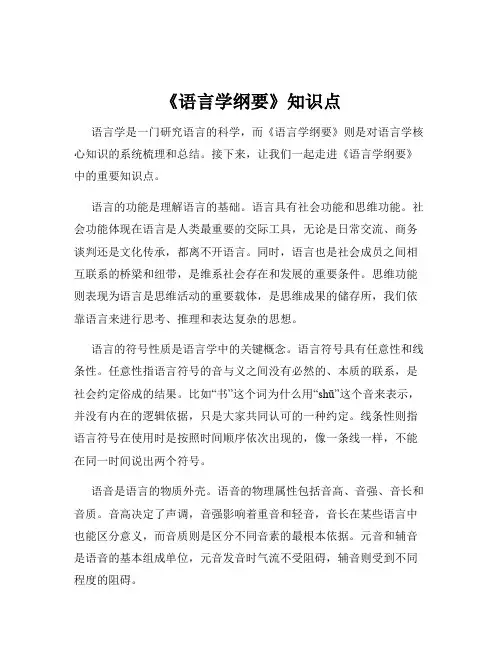
《语言学纲要》知识点语言学是一门研究语言的科学,而《语言学纲要》则是对语言学核心知识的系统梳理和总结。
接下来,让我们一起走进《语言学纲要》中的重要知识点。
语言的功能是理解语言的基础。
语言具有社会功能和思维功能。
社会功能体现在语言是人类最重要的交际工具,无论是日常交流、商务谈判还是文化传承,都离不开语言。
同时,语言也是社会成员之间相互联系的桥梁和纽带,是维系社会存在和发展的重要条件。
思维功能则表现为语言是思维活动的重要载体,是思维成果的储存所,我们依靠语言来进行思考、推理和表达复杂的思想。
语言的符号性质是语言学中的关键概念。
语言符号具有任意性和线条性。
任意性指语言符号的音与义之间没有必然的、本质的联系,是社会约定俗成的结果。
比如“书”这个词为什么用“shū”这个音来表示,并没有内在的逻辑依据,只是大家共同认可的一种约定。
线条性则指语言符号在使用时是按照时间顺序依次出现的,像一条线一样,不能在同一时间说出两个符号。
语音是语言的物质外壳。
语音的物理属性包括音高、音强、音长和音质。
音高决定了声调,音强影响着重音和轻音,音长在某些语言中也能区分意义,而音质则是区分不同音素的最根本依据。
元音和辅音是语音的基本组成单位,元音发音时气流不受阻碍,辅音则受到不同程度的阻碍。
词汇是语言的建筑材料。
词的构造方式多种多样,有单纯词、合成词等。
单纯词由一个语素构成,如“天”“地”;合成词则由两个或两个以上的语素构成,如“火车”“计算机”。
词汇的发展变化表现为新词的产生、旧词的消亡和词义的演变。
词义具有概括性、模糊性和民族性等特点。
语法是语言的结构规则。
句子是语法研究的重要单位,根据结构可以分为主谓句、动宾句等不同类型。
语法手段包括词序、虚词、形态变化等。
比如在汉语中,词序非常重要,“我吃饭”和“饭吃我”意思完全不同。
语言的发展具有不平衡性和渐变性。
不同的语言要素发展速度不同,比如词汇发展较快,语法相对稳定。
语言的发展是逐渐变化的,不会突然发生巨大的改变。
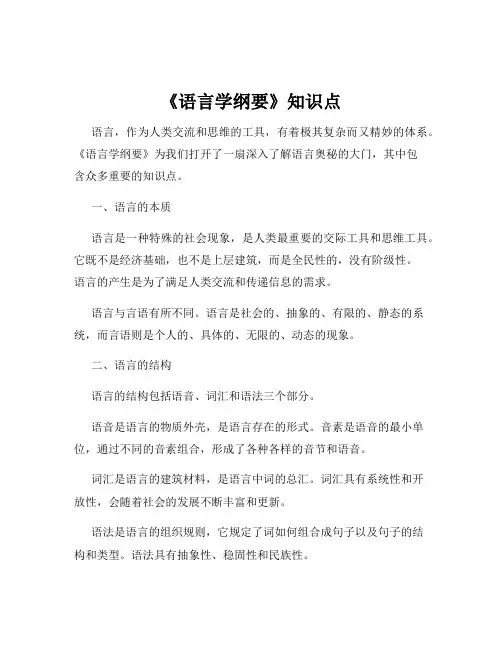
《语言学纲要》知识点语言,作为人类交流和思维的工具,有着极其复杂而又精妙的体系。
《语言学纲要》为我们打开了一扇深入了解语言奥秘的大门,其中包含众多重要的知识点。
一、语言的本质语言是一种特殊的社会现象,是人类最重要的交际工具和思维工具。
它既不是经济基础,也不是上层建筑,而是全民性的,没有阶级性。
语言的产生是为了满足人类交流和传递信息的需求。
语言与言语有所不同。
语言是社会的、抽象的、有限的、静态的系统,而言语则是个人的、具体的、无限的、动态的现象。
二、语言的结构语言的结构包括语音、词汇和语法三个部分。
语音是语言的物质外壳,是语言存在的形式。
音素是语音的最小单位,通过不同的音素组合,形成了各种各样的音节和语音。
词汇是语言的建筑材料,是语言中词的总汇。
词汇具有系统性和开放性,会随着社会的发展不断丰富和更新。
语法是语言的组织规则,它规定了词如何组合成句子以及句子的结构和类型。
语法具有抽象性、稳固性和民族性。
三、语言的发展语言的发展是一个渐变的过程,包括语言的分化和统一。
语言的分化有社会方言和地域方言之分。
社会方言是由于社会阶层、职业、年龄等因素导致的语言变体;地域方言则是由于地域差异形成的不同语言形式。
语言的统一则表现为共同语的形成和推广。
共同语是一个社会全体成员通用的语言形式。
四、语言的接触不同语言之间会相互接触和影响。
语言接触的形式有借词、语言融合等。
借词是指一种语言从另一种语言中借入词汇。
例如,汉语中的“咖啡”“沙发”等就是从外语借入的词汇。
语言融合是指一种语言取代其他语言成为主要的交际工具。
这通常发生在语言接触频繁、经济文化发展不平衡的情况下。
五、语言系统的演变语音、词汇和语法在语言的发展过程中都会发生变化。
语音演变具有规律性,比如音位的合并和分化。
词汇的演变表现为新词的产生、旧词的消亡以及词义的演变。
语法的演变则较为缓慢,但也会出现语序的改变、语法范畴的变化等情况。
六、语言与思维的关系语言和思维密切相关,但又不是等同的。
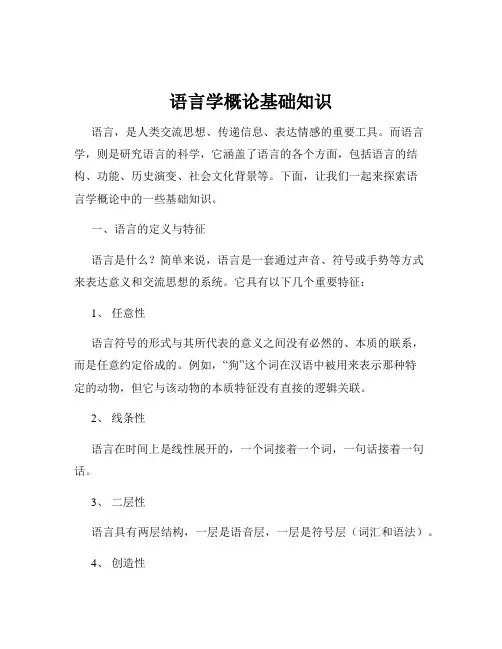
语言学概论基础知识语言,是人类交流思想、传递信息、表达情感的重要工具。
而语言学,则是研究语言的科学,它涵盖了语言的各个方面,包括语言的结构、功能、历史演变、社会文化背景等。
下面,让我们一起来探索语言学概论中的一些基础知识。
一、语言的定义与特征语言是什么?简单来说,语言是一套通过声音、符号或手势等方式来表达意义和交流思想的系统。
它具有以下几个重要特征:1、任意性语言符号的形式与其所代表的意义之间没有必然的、本质的联系,而是任意约定俗成的。
例如,“狗”这个词在汉语中被用来表示那种特定的动物,但它与该动物的本质特征没有直接的逻辑关联。
2、线条性语言在时间上是线性展开的,一个词接着一个词,一句话接着一句话。
3、二层性语言具有两层结构,一层是语音层,一层是符号层(词汇和语法)。
4、创造性人们可以利用有限的语言规则和词汇创造出无限的新句子和表达。
5、移位性语言可以用来谈论过去、未来以及不在眼前的事物。
6、文化传承性语言承载着一个民族或社会的文化传统、价值观和知识体系。
二、语言的结构语言的结构包括语音、词汇和语法三个主要方面。
1、语音语音是语言的物质外壳,是语言符号的声音表现形式。
不同的语言有不同的语音系统,包括元音、辅音、声调、重音等。
例如,汉语中的声调变化可以区分不同的字词意义。
2、词汇词汇是语言的建筑材料,是语言中词的总汇。
词汇反映了语言所表达的概念和事物。
新的事物和概念的出现会推动词汇的不断发展和更新。
3、语法语法是语言的组织规则,它规定了词如何组合成句子以及句子之间的关系。
语法包括词法和句法。
词法研究词的构成和变化规则,句法研究句子的结构和类型。
三、语言的功能语言具有多种功能,主要包括以下几种:1、交际功能这是语言最基本的功能,用于人与人之间的信息交流和思想沟通。
2、思维功能语言是思维的工具,我们借助语言进行思考、分析和推理。
3、记录功能语言可以将人类的经验、知识和文化记录下来,传承给后代。
4、情感表达功能通过语言,我们能够表达喜怒哀乐等各种情感。
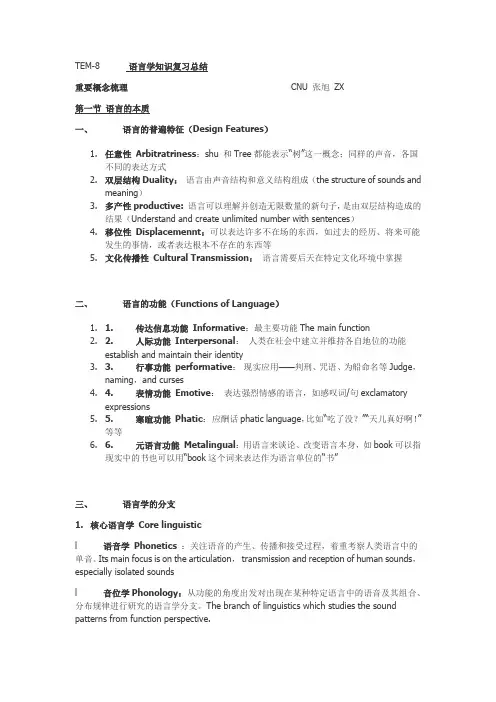
TEM-8 语言学知识复习总结重要概念梳理CNU 张旭ZX第一节语言的本质一、语言的普遍特征(Design Features)1.任意性Arbitratriness:shu 和Tree都能表示“树”这一概念;同样的声音,各国不同的表达方式2.双层结构Duality:语言由声音结构和意义结构组成(the structure of sounds andmeaning)3.多产性productive:语言可以理解并创造无限数量的新句子,是由双层结构造成的结果(Understand and create unlimited number with sentences)4.移位性Displacemennt:可以表达许多不在场的东西,如过去的经历、将来可能发生的事情,或者表达根本不存在的东西等5.文化传播性Cultural Transmission:语言需要后天在特定文化环境中掌握二、语言的功能(Functions of Language)1. 1. 传达信息功能Informative:最主要功能The main function2. 2. 人际功能Interpersonal:人类在社会中建立并维持各自地位的功能establish and maintain their identity3. 3. 行事功能performative:现实应用——判刑、咒语、为船命名等Judge,naming,and curses4. 4. 表情功能Emotive:表达强烈情感的语言,如感叹词/句exclamatoryexpressions5. 5. 寒暄功能Phatic:应酬话phatic language,比如“吃了没?”“天儿真好啊!”等等6. 6. 元语言功能Metalingual:用语言来谈论、改变语言本身,如book可以指现实中的书也可以用“book这个词来表达作为语言单位的“书”三、语言学的分支1. 核心语言学Core linguisticl 语音学Phonetics:关注语音的产生、传播和接受过程,着重考察人类语言中的单音。

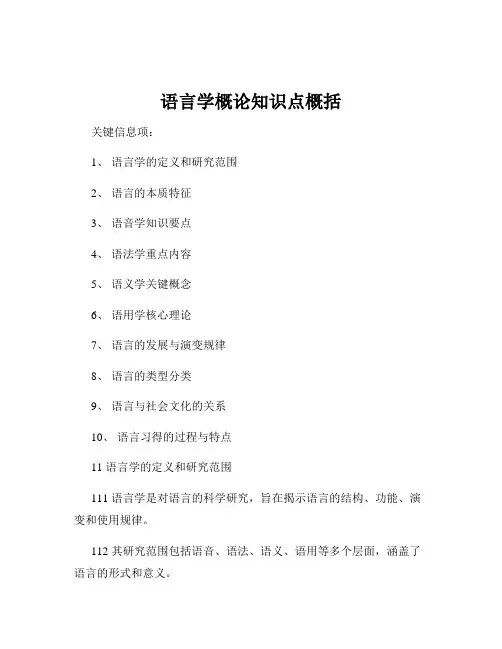
语言学概论知识点概括关键信息项:1、语言学的定义和研究范围2、语言的本质特征3、语音学知识要点4、语法学重点内容5、语义学关键概念6、语用学核心理论7、语言的发展与演变规律8、语言的类型分类9、语言与社会文化的关系10、语言习得的过程与特点11 语言学的定义和研究范围111 语言学是对语言的科学研究,旨在揭示语言的结构、功能、演变和使用规律。
112 其研究范围包括语音、语法、语义、语用等多个层面,涵盖了语言的形式和意义。
12 语言的本质特征121 语言是一种符号系统,具有任意性、线条性和系统性。
122 语言具有交际功能,是人类最重要的交际工具。
123 语言是人类思维的工具,与思维相互依存、相互促进。
13 语音学知识要点131 语音的物理属性,如音高、音强、音长和音色。
132 元音和辅音的分类及发音特点。
133 语音的组合规则和音位系统。
14 语法学重点内容141 词法和句法的基本概念。
142 语法范畴,如性、数、格、时、体、态等。
143 句子的结构类型和分析方法。
15 语义学关键概念151 词汇意义和语法意义的区别与联系。
152 语义的组合与聚合关系。
153 语义的变化和引申。
16 语用学核心理论161 言语行为理论,包括言内行为、言外行为和言后行为。
162 会话含义和合作原则。
163 语境对语言理解和表达的影响。
17 语言的发展与演变规律171 语言的历史演变过程,包括语音、词汇、语法的变化。
172 语言演变的原因,如社会发展、语言接触等。
173 语言演变的特点,如渐变性、不平衡性等。
18 语言的类型分类181 按照语法结构,可分为孤立语、屈折语、粘着语和复综语。
182 按照语言的亲属关系,可分为语系、语族、语支等。
19 语言与社会文化的关系191 语言是社会文化的载体,反映了社会的变迁和文化的特点。
192 社会文化对语言的使用和发展产生影响。
193 语言的性别差异、地域差异和社会阶层差异。
110 语言习得的过程与特点1101 儿童语言习得的阶段和规律。
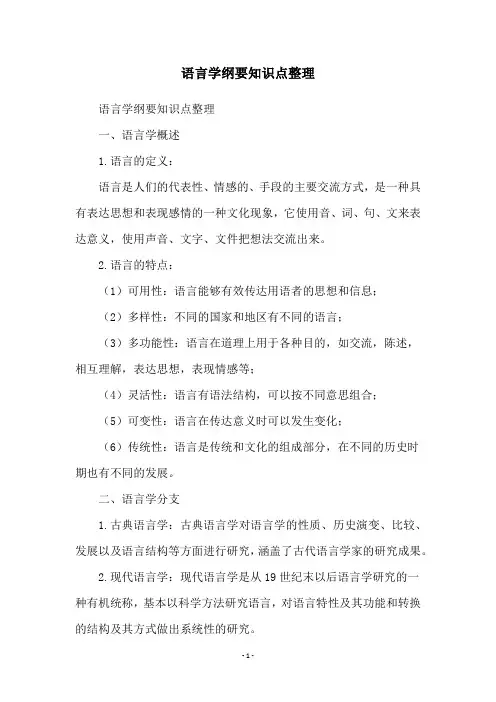
语言学纲要知识点整理语言学纲要知识点整理一、语言学概述1.语言的定义:语言是人们的代表性、情感的、手段的主要交流方式,是一种具有表达思想和表现感情的一种文化现象,它使用音、词、句、文来表达意义,使用声音、文字、文件把想法交流出来。
2.语言的特点:(1)可用性:语言能够有效传达用语者的思想和信息;(2)多样性:不同的国家和地区有不同的语言;(3)多功能性:语言在道理上用于各种目的,如交流,陈述,相互理解,表达思想,表现情感等;(4)灵活性:语言有语法结构,可以按不同意思组合;(5)可变性:语言在传达意义时可以发生变化;(6)传统性:语言是传统和文化的组成部分,在不同的历史时期也有不同的发展。
二、语言学分支1.古典语言学:古典语言学对语言学的性质、历史演变、比较、发展以及语言结构等方面进行研究,涵盖了古代语言学家的研究成果。
2.现代语言学:现代语言学是从19世纪末以后语言学研究的一种有机统称,基本以科学方法研究语言,对语言特性及其功能和转换的结构及其方式做出系统性的研究。
3.比较语言学:比较语言学是以比较固有语言的形式及其结构为主要研究对象的语言学。
它以比较研究为宗旨,以比较语言的形式及其结构特征、历史变化等为研究对象,也是探讨语言的演变过程的一个重要学科。
三、语言学方法1.语料库:语料库指语料学研究研究对象,是按照一定的话题内容,经过统计、清洗的数据库,其中有现代语言学和社会语言学研究的重要组成部分。
2.实验:实验是根据定义的研究问题、研究目的,制定研究设计、实施实验方案,经过量化、图形处理评价,来检测数据的有效性,以及不同群体的对比实验,以期获得可靠的语言现象的结论。
3.分析:分析是根据实验获得的观察语料,通过观察、比较、识别等方法,分析其构成,推断其内部性质,以期把握及理解语言现象。
4.理论建构:理论建构是在实证数据的基础上,结合实证分析推断出的观点,通过咨询和汇总,进行理性思维,形成语言学的理论。
语言学核心知识点总结语言学是研究语言结构、功能及其演变的学科。
以下是语言学的核心知识点总结:1. 语言学的分支语音学(Phonetics):研究语言的语音,包括语音的发音(发音语音学)、传递(声学语音学)以及感知(听觉语音学)。
音系学(Phonology):研究语音系统及其功能,关注不同语言如何使用不同的音素来构造词汇。
形态学(Morphology):研究词的内部结构和构词法,分析词素(词的最小意义单位)如何组合成词。
句法学(Syntax):研究词在句子中的排列和结构规则,探讨语言如何构造句子。
语义学(Semantics):研究语言的意义,分析词汇和句子的含义。
语用学(Pragmatics):研究语言在实际交际中的使用,涉及言语行为、话语背景和语境的影响。
2. 语言的基本单位音素(Phoneme):最小的语音单位,不具有意义,但能区分词义。
如英语中的/p/和/b/。
词素(Morpheme):最小的有意义单位,分为自由词素(可以独立成词)和黏着词素(需要依附于其他词素)。
词汇(Lexicon):语言中的所有词汇的集合,是语言使用者词汇知识的反映。
句子(Sentence):由词和短语按照语法规则组成的结构单元,表达完整的意思。
3. 语言的演变与发展语音变化(Sound Change):语音系统随着时间演变,如“长元音推移”是英语音系发展的重要变化。
语法变化(Grammatical Change):包括句法、形态等方面的变化,如古英语到现代英语的语法简化。
词汇变化(Lexical Change):新词的产生、旧词的消亡或意义的变化。
4. 语言的社会功能社会语言学(Sociolinguistics):研究语言与社会的关系,涉及方言、语言变体、社会阶层、性别等因素。
语言接触与借词(Language Contact):不同语言接触时会相互影响,产生借词、语言混合等现象。
双语和多语现象(Bilingualism & Multilingualism):研究双语者或多语者如何在不同语言之间切换,以及语言如何在社会中共存。
英语语言学知识点整理一、语言与语言学1、语言是什么?语言是一种符号系统,它由语音、词汇、语法和语用规则等构成。
2、语言学是什么?语言学是研究语言及其规律的科学,是社会科学的一门重要学科。
3、语言学的分支学科有哪些?语言学可以分为语音学、音系学、句法学、语义学、语用学等分支学科。
二、语音学与音系学1、语音学是什么?语音学是研究语音的学科,主要研究语音的物理属性、发音机制和语音的变化规律。
2、音系学是什么?音系学是研究语言的音系系统的学科,它的是语言的音位、音素、音节、语素等基本单位以及它们之间的组合关系和变化规律。
3、语音和音系的关系是什么?语音是音系的具体表现形式,而音系则是语音的基础和框架。
语音受到个人的发音和语境的影响,而音系则是一种抽象的概念,它是语言社团所共同遵守的规则。
三、句法学1、句法学是什么?句法学是研究句子的结构和规律的学科。
它主要的是词类、句子成分的构成和它们之间的组合关系。
2、句法学的核心概念有哪些?句法学的核心概念包括:词类、句子成分、句法关系、句型等。
3、常见的句法结构有哪些?常见的句法结构包括:简单句、复合句、并列句、复合并列句等。
四、语义学1、语义学是什么?语义学是研究语言意义的学科,主要研究词义、短语意义、句子意义和语篇意义等。
2、语义的分类有哪些?语义可以分为词汇意义、语法意义和语用意义。
词汇意义是指词汇的基本意义,语法意义是指词汇在句子中的组合关系和变化规律,语用意义是指词汇在特定语境中的特殊意义。
3、语义关系有哪些?语义关系包括:同义关系、反义关系、上下义关系等。
同义关系是指两个或多个词义相同或相似的词语之间的关系,反义关系是指两个或多个词义相反的词语之间的关系,上下义关系是指一个词所表达的概念是另一个词所表达的概念的一部分。
语言学知识点整理语言学是一门研究人类语言的学科,涉及语言的各个方面,包括语言的结构、使用、习得和进化等。
以下是一些常见的语言学知识点:1、语言与言语:语言是指一种符号系统,是人们用来表达思想、情感和意愿的工具。
《语言学纲要》重点知识总结(考研+期末)●一.语言学的对象和学科性质●(一)语言学的研究对象语言学是以人类语言为研究对象的学科,探索范围包括语言的性质、功能、结构、运用和历史发展,以及其他与语言有关的问题。
语言学研究的对象是客观存在的语言事实。
●1.语言现象是人类社会普遍具有的现象,是人类生活中最司空见惯的现象●一些古代神话传说已经反映出古人对于语言在交流信息以及沟通思想过程中所发挥的作用●几大古代文明如中国、古印度、古希腊-罗马,那时的哲学家们都开展过对语言现象的研究。
这些对语言的最初的理性认识产生了深远影响●2.语言学的发展过程●(1)古代的语文学●在古代,人们把语言的知识看作阅读古书的工具,利用语言的知识对古书进行注释和校勘,帮助人们阅读古代的典籍,由此产生了古代的语文学。
古代语文学家研究古代书面语的语音、词汇、语法和文字的成果在文学、哲学、历史、逻辑等学科的文献阅读、整理中起了重要的作用●(2)语言学三大发源地成就●1⃣️中国●文言是中国古代具有正宗地位的书面语言,具有口头语言无可比拟的典雅性和简洁性。
自先秦开始,文言便作为古代正统文学所使用的语言为后世所沿袭。
“五四”白话文运动开展之前,正式的书面语一直使用文言文的形式●训诂学、文字学、音韵学是中国古人研究语言文字的三门学问,统称“小学”●2⃣️古代印度●古代印度的语言研究主要是解读经典。
这些经典主要是宗教典籍,所用的语言是古代的梵语。
最初这些经典是靠口耳相传,后来由文字记载●古梵文的语音、语法与古印度口语表达之间的巨大差异性促使学者加紧了对语音、语法的研究●3⃣️古希腊-罗马●古希腊哲学家在语法研究方面取得辉煌成就,自柏拉图起,古希腊人就不断地对古希腊语的词和句子进行语法分析。
为了保存《荷马史诗》等典籍的需要,在亚历山大里亚出现了注释、考证、校勘《荷马史诗》等古代文献的语文学派。
大约在公元前1c起,特拉斯把前人的研究成果编成了《语法术》,形成了比较系统的古希腊语语法●古罗马在继承古希腊语言研究的基础上形成系统化的书面拉丁语研究。
英语语言学语言学知识点语言学是一门研究语言的学科。
它涵盖了多个领域,包括语音学、语法学、语义学、语用学和语言变化等。
下面将简要介绍一些语言学的重要知识点。
一、语音学(Phonetics)语音学是研究语音的学问。
它关注语音的产生、传播和感知等方面。
在语音学中,语音被分为音素(phoneme)和音位(allophone)。
音素是语言中最小的语音单位,可以在语言中起到区分意义的作用。
而音位是相同意义的不同实现方式,即同一音素的不同发音形式。
在语音学中,还有一些重要概念,如元音(vowel)和辅音(consonant)。
元音是语音学中最基本、最重要的音类,它们的发音不受任何阻塞或摩擦的干扰。
而辅音则需要通过口腔或喉头的阻塞或摩擦才能产生。
二、语音语调学(Phonology)语音语调学是研究语音和语调现象的学问。
它研究语音和语音的组织方式和相互关系。
在语音语调学中,音位和音位组成规则是核心概念之一、音位组成规则决定了在一个语言中哪些音位可以成为合法的音节。
此外,在语音语调学中还有音变(phonological variation)的概念。
音变指的是在其中一种语言中,一个特定音位的发音方式会随着不同的语音环境而发生变化的现象。
音变是语言变化的一种重要表现。
三、语法学(Grammar)语法学是研究语言的结构和规则的学问。
在语法学中,句子是一个重要的研究对象。
句子结构可以划分为短语(phrase)和句子成分(sentence constituents),如名词短语、动词短语和介词短语等。
语法学还涉及到句子的成分顺序和组成规则。
在语法学中,句法树(syntactic tree)是一种图形表示方式,用于描述句子的结构。
句法树由句子的各个成分和它们之间的关系构成。
四、语义学(Semantics)语义学是研究词汇和句子意义的学问。
它关注词语和句子的语义性质、意义的产生机制以及词义的转换等。
在语义学中,可以通过语义角色(semantic role)和逻辑关系(logical relation)来描述词语和句子之间的关系。
语言的演变与变异语言学知识点语言是人类思维和交流的工具,随着时间的推移,不同语言会发生演变和变异。
语言学是研究语言的学问,它涵盖了许多知识点,例如语音学、词汇学、语法学等。
本文将探讨语言的演变与变异以及其中的语言学知识点。
一、语言的演变1.历史演变语言随着社会的发展和文化的变迁而逐渐演变。
例如,英语经历了古英语、中古英语和现代英语等阶段,每个阶段都有不同的语法和词汇特点。
这些演变可能是由于外来文化的影响、技术的进步或社会变革引起的。
2.地理演变地理因素也对语言演变产生影响。
例如,同一语言在不同地理环境下可能形成不同的方言,因为不同区域的人们在语音、词汇和语法等方面有所差异。
这种地理演变还可能导致语言的分化,形成新的语言。
3.社会演变社会因素也会促使语言发生演变。
随着社会结构的变化和文化的发展,语言可能需要适应新的领域和需求。
例如,科技和商业的进步导致了许多新词汇的产生,这些词汇反映了当代社会的变化。
二、语言的变异1.地区变异语言的变异可以是地区性的,即不同地区的人们使用同一语言时,可能会有不同的发音、词汇和语法。
这种变异可以通过方言研究进行探索,有助于了解语言在不同地理环境中的变化。
2.社会变异语言的变异也可以是社会性的,即不同社会群体之间使用同一语言时可能会有不同的语言风格、词汇选择和语法结构。
例如,不同年龄、性别、职业和社会阶层的人们可能会使用不同的术语和表达方式。
3.个体变异每个人的语言使用都有一定的个体差异,即使是使用同一语言的人们之间,也可能存在个别差异。
这种个体变异可能来源于个人的语言习惯、教育背景和社会经历等因素。
三、语言学知识点1.语音学语音学研究语言的发音特点和音位系统。
它关注语音的产生、分类和描述,例如不同语言中的声调、辅音和元音等。
2.词汇学词汇学研究词汇的形成和使用。
它研究词汇的构词法、词义学和语用学等方面,帮助我们理解词汇的演变和语义变化。
3.语法学语法学研究语言的句法结构和规则。
I. Introduction 1. What is Language Language is a system of arbitrary vocal symbols used for human communication.
2. What is Linguistics(语言学) Linguistics is the scientific study of language.
3.Some Basic Distinctions(区分) in Linguistics 3.1 Speech and Writing One general principle(原则) of linguistic analysis is the primacy of speech over writing. Writing gives language new scope(范畴) and uses that speech does not have. 3.2 Descriptive(描述性) or Prescriptive(说明性) A linguistic study is descriptive if it describes and analyses facts observed; it is prescriptive if it tries to lay down rules for "correct" behavior. 3.3 Synchronic(共时) and Diachronic(历时) Studies The description of a language at some point in time is a synchronic study and The description of a language as it changes through time is a diachronic study. 3.4 Langue(语言) and Parole(言语) This is a distinction made by the Swiss linguist F.De Saussure (索绪尔)early last century. langue refers to the abstract linguistic system shared by all the members of a speech community and parole refers to the actualized(实际的) language, or realization of langue. 3.5 Competence(能力)and Performance(行为) Competence is the ideal language user's knowledge of the rules of his language. Performance is the actual realization of this knowledge in utterances(发声).
4.The Scope of Linguistics General linguistics is the study of language as a whole. Phonetics(语音学) is the branch of linguistics which studies the characteristics of speech sounds and provides methods for their description, classification and transcription. Phonology(音韵学) is the branch of linguistics which studies the sound patterns of languages. Morphology(词法) is the branch of linguistics which studies the form of words. Syntax(句法) is the branch of linguistics which studies the rules governing the combination of words into sentences. Semantics(语义学) is the branch of linguistics which studies the meaning of language. Applied linguistics(应用语言学) is the study of the teaching of foreign and second languages. Sociolinguistics is the study of the relationship between language and society. Psycholinguistics is the study of the relationship between language and the mind. Historical Linguistics(历史语言学) is the study of language changes. Anthropological linguistics(人文语言学) uses the theories and methods of anthropology to study language variation and language use in relation to the cultural patterns and beliefs of man. Neurolinguistics(神经语言学) studies the neurological basis of language development and use in human beings. Mathematical linguistics(数学语言学) studies the mathematical features of language, often employing models and concepts of mathematics. Computational linguistics(计算语言学) is an approach to linguistics in which mathematical techniques and concepts(概念) are applied, often with the aid of a computer.
作者: 枫林恋人 2005-12-9 12:51 回复此发言 2[增长阅历]:学点语言学 II. Phonetics(语音学) 1. scope of phonetics Speech sounds may be studied from different angles, thus we have at least three branches of phonetics: Articulatory phonetics(发音语音学)we may examine the way in which a speech sound is produced to discover which vocal organs are involved and how they coordinate(协调) in the process. Auditory phonetics (听觉语音学)we may look into the impression a speaker makes on the hearer as mediated(调节) by the ear, the auditory nerve(神经) and the brain. Acoustic phonetics (声学语音学) we study the physical properties of speech sounds, as transmitted(传送) between mouth and ear. 2. The vocal organs The vocal organs may be viewed as consisting of three parts, the initiator of the air-stream,(气流发生器官) the producer of voice(声音发生器官) and the resonating cavities.(声音共振器官)
3. Consonants(辅音) Places of articulation(发音部位): bilabial,(双唇) Labiodentals,(唇齿) dental,(齿) alveolar,(齿龈) retroflex,(卷舌) palate-alveolar,(上齿龈) palatal,(上颚) velar,(软腭) uvular,(小舌) glottal(声门) Manners of articulation: plosive,(暴破) nasal,(鼻音) trill,(颤音) lateral,(边音) fricative,(摩擦) approximant,(近似音) affricate(破擦)
4. Vowels (元音) The classification of vowels: the height of tongue raising (high, mid, low), the position of the highest part of the tongue(front, central, back), and the degree of lip rounding(rounded, unrounded)
III. Phonology(音韵学) 1. phonemes(音素):a distinctive(有区别的) sound in a language.
2. Allophones(音位变体):The nondistinctive sounds are members of the same phoneme.
3. Minimal pairs(最小对立体): word forms which differ from each other only by one sound.